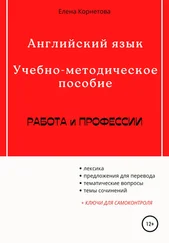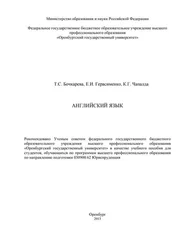Елена Беликова - Английский язык для медиков
Здесь есть возможность читать онлайн «Елена Беликова - Английский язык для медиков» — ознакомительный отрывок электронной книги совершенно бесплатно, а после прочтения отрывка купить полную версию. В некоторых случаях можно слушать аудио, скачать через торрент в формате fb2 и присутствует краткое содержание. Город: Москва, Год выпуска: 2008, ISBN: 2008, Издательство: Array Конспекты, шпаргалки, учебники «ЭКСМО», Жанр: Языкознание, Медицина, на русском языке. Описание произведения, (предисловие) а так же отзывы посетителей доступны на портале библиотеки ЛибКат.
- Название:Английский язык для медиков
- Автор:
- Издательство:Array Конспекты, шпаргалки, учебники «ЭКСМО»
- Жанр:
- Год:2008
- Город:Москва
- ISBN:978-5-699-24046-3
- Рейтинг книги:4 / 5. Голосов: 1
-
Избранное:Добавить в избранное
- Отзывы:
-
Ваша оценка:
- 80
- 1
- 2
- 3
- 4
- 5
Английский язык для медиков: краткое содержание, описание и аннотация
Предлагаем к чтению аннотацию, описание, краткое содержание или предисловие (зависит от того, что написал сам автор книги «Английский язык для медиков»). Если вы не нашли необходимую информацию о книге — напишите в комментариях, мы постараемся отыскать её.
Английский язык для медиков — читать онлайн ознакомительный отрывок
Ниже представлен текст книги, разбитый по страницам. Система сохранения места последней прочитанной страницы, позволяет с удобством читать онлайн бесплатно книгу «Английский язык для медиков», без необходимости каждый раз заново искать на чём Вы остановились. Поставьте закладку, и сможете в любой момент перейти на страницу, на которой закончили чтение.
Интервал:
Закладка:
Eosinophils: they have a bilobed nucleus and possess acid granulations in their cytoplasm. These granules contain hydrolytic enzymes and peroxidase, which a discharged into phagocytic vacuoles.
Eosinophils are more numerous in the blood during allergic diseases; they norma asent only – 3 % of leukocytes.
Basophils: they possess large spheroid granules, which are basophilic and metachromatic.
Basophils degranulate in certain immune reaction, releasing heparin and histamine into their surroundings. They also release additional vasoactive amines and slow reacting substance of anaphylaxis (SRS—A) consisting of leu—kotrienes LTC4, LTD4, and LTE4. They represent less than 1 % – of leukocytes.
Agranulocytes are named according to their lack of specific granules. Lymphocytes are generally small cells measuring 7—10 mm in diameter and constitute 25–33 % of leukocytes. They con tain circular dark—stained nuclei and scanty clear blue cyto plasm. Circulating lymphocytes enter the blood from the lymphatic tissues. Two principal types of immunocompetent lymphocytes can be identified T lymphocytes and В lymphocytes.
T cells differentiate in the thymus and then circulate in the peripheral blood, where they are the principal effec tors of cell—mediated immunity. They also function as helper and suppressor cells, by modulating the immune response through their effect on В cells, plasma cells, mac—rophages, and other T Cells.
В cells differentiate in bone marrow. Once activated by contact with an antigen, they differentiate into plasma cells, which synthesize antibodies that are secreted into the blood, intercellular fluid, and lymph. В lymphocytes also give rise to memory cells, which differentiate into plas ma cells only after the second exposure to the antigen. Monocytes vary in diameter from 15–18 mm and are the largest of the peripheral blood cells. They constitute 3–7 % of leukocytes.
Monocytes possess an eccentric nucleus. The cytoplasm has a ground—glass appearance and fine azurophilic granules.
Monocytes are the precursors for members of the mo—nonuclear phagocyte system, including tissue macropha—ges (histiocytes), osteoclasts, alveolar macrophages, and Kupffer cells of the liver.
New words
mesodermal – мезодермальный
erythrocytes – эритроциты
leukocytes – лейкоциты
fibrous proteins – волокнистые белки
immune – иммунный
humoral – гуморальный
to contain – содержать
nuclei – ядра
20. Plasma
Plasma is the extracellular component of blood. It is an aqueous solution containing proteins, inorganic salts, and organic com pounds. Albumin is the major plasma protein that maintains the osmotic pressure of blood. Other plasma proteins include the globulins (alpha, beta, gamma) and fibrino—gen, which is necessary for the formation of fibrin in the final step of blood coagulation. Plasma is in equilibrium with tissue interstitial fluid through capil lary walls; therefore, the composition of plasma may be used to judge the mean composition of the extracellular fluids. Large blood proteins remain in the intravascular compartment and do not equilibrate with the interstitial fluid. Serum is a clear yellow fluid that is separated from the coagulum during the process of blood clot formation. It has the same com position as plasma, but lacks the clotting factors (especially fib rinogen).
Lymphatic vessels
Lymphatic vessels consist of a, fine network of thin—walled vessels that drain into progressively larger and progressively thicker—walled collecting trunks. These ultimately drain, via the thoracic duct and right lymphatic duct, into the left and right subclavian veins at their angles of junction with the internal jugular veins, respectively. The lymphatics serve as a one—way (i. e., toward the heart) drainage sys tem for the return of tissue fluid and other diffusible substances, including plasma proteins, which constantly escape from the blood through capillaries. They are also important in serving as a conduit for channeling lymphocytes and antibodies produced in lymph nodes into the blood circulation.
Lymphatic capillaries consist of vessels lined with en—dothelial cells, which begin as blind—ended tubules or sac—cules in most tis sues of the body. Endothelium is attenuated and usually lacks a continuous basal lamina. Lymphatic vessels of large diameter resemble veins in their struc ture but lack a clear—cut separation between layers. Valves are more numerous in lymphatic vessels. Smooth muscle cells in the media layer engage in rhythmic contraction, pumping lymph toward the venous system. Smooth muscle is well—developed in large lymphatic ducts.
Circulation of lymph is slower than that of blood, but it is nonetheless an essential process. It has been estimated that in a single day, 50 % or more of the total circulating protein leaves the blood circulation at the capillary level and is recaptured by the lymphatics.
Distribution of lymphatics is ubiquitous with some notable excep tions, including epithelium, cartilage, bone, central nervous sys tem, and thymus.
New words
plasma – плазма
extracellular – внеклеточный
aqueous – водный
solution – раствор
proteins – белки
inorganic – неорганический
salts – соли
organic – органический
albumin – альбумин
globulins – глобулины
alpha – альфа
beta – бета
gamma – гамма
fibrinogen – фибриноген
lymphatic – лимфатический
vessel – сосуд
endothelium – эндотелий
circulation – кровообращение
lymph – лимфа
ubiquitous – вездесущий
notable – известный
21. Hematopoietic tissue. Erythropoiesis
Hematopoietic tissue is composed of reticular fibers and cells, blood vessels, and sinusoids (thin—walled blood channels). Myeloid, or blood cell—forming tissue, is found in the bone marrow and provides the stem cells that develop into erythrocytes, granulocytes, agranulocytes, and platelets. Red marrow is characterized by active hemato—poiesis; yellow bone marrow is inactive and contains mostly fat cells. In the human adult, hematopoiesis takes place in the mar row of the flat bones of the skull, ribs and sternum, the vertebral column, the pelvis, and the proximal ends of some long bones. Erythropoiesis is the process of RBC formation. Bone marrow stem cells (colony—forming units, CFUs) differentiate into proerythroblasts under the influence of the glycoprotein erythropoietin, which is produced by the kidney.
Proerythroblast is a large basophilic cell containing a large spherical euchromatic nucleus with prominent nucleoli.
Basophilic erythroblast is a strongly basophilic cell with nucleus that comprises approximately 75 % of its mass. Numerous cytoplasmic polyribosomes, condensed chro—matin, no visible nucleoli, and continued hemoglobin synthesis characteristics of this cell.
Polychromatophilic erythroblast is the last cell in this line undergoes mitotic divisions. Its nucleus comprises approximately 50 % of its mass and contains condensed chroma—tin which appears in a «checkerboard» pattern. The po—lychnsia of the cytoplasm is due to the increased quantity of acidophilic hemoglobin combined with the basophilia of cytoplasmic polyribosomes.
Normoblast (orthochromatophilic erythroblast) is a cell with a small heterochromatic nucleus that comprises ap proximately 25 % of its mass. It contains acidophilic cytoplasm because the large amount of hemoglobin and degenerating organelles. The pyknotic nucleus, which is no longer capable of division, is extruded from the cell.
Читать дальшеИнтервал:
Закладка:
Похожие книги на «Английский язык для медиков»
Представляем Вашему вниманию похожие книги на «Английский язык для медиков» списком для выбора. Мы отобрали схожую по названию и смыслу литературу в надежде предоставить читателям больше вариантов отыскать новые, интересные, ещё непрочитанные произведения.
Обсуждение, отзывы о книге «Английский язык для медиков» и просто собственные мнения читателей. Оставьте ваши комментарии, напишите, что Вы думаете о произведении, его смысле или главных героях. Укажите что конкретно понравилось, а что нет, и почему Вы так считаете.












